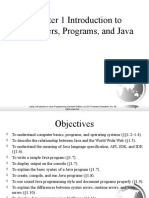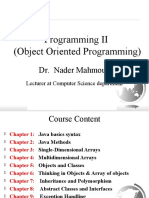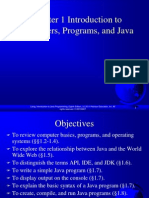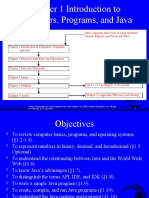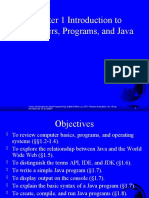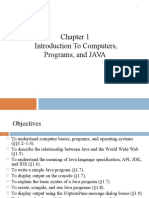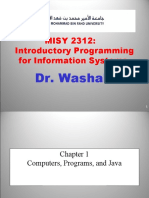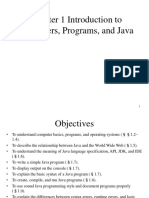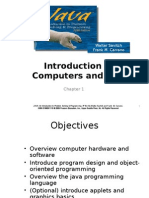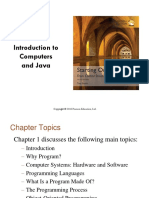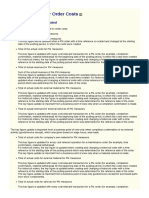TM105: Introduction to Computer
Programming
Meeting 1 (Chapter 1)
Introduction to Computers, Programs, and Java
Liang, Introduction to Java Programming, Eleventh Edition, (c) 2017 Pearson Education, Inc. All rights reserved. 1
� Objectives
To understand computer basics, programs, and operating
systems.
To describe the relationship between Java and the World
Wide Web.
To write a simple Java program.
To explain the basic syntax of a Java program.
To create, compile, and run Java programs.
To develop Java programs using NetBeans.
Liang, Introduction to Java Programming, Eleventh Edition, (c) 2017 Pearson Education, Inc. All rights reserved. 2
� What is a Computer?
A computer consists of a CPU, memory, hard disk, floppy disk,
monitor, printer, and communication devices.
Bus
Storage Communication Input Output
Devices Memory CPU Devices Devices Devices
e.g., Disk, CD, e.g., Modem, e.g., Keyboard, e.g., Monitor,
and Tape and NIC Mouse Printer
Liang, Introduction to Java Programming, Eleventh Edition, (c) 2017 Pearson Education, Inc. All rights reserved. 3
� CPU
The central processing unit (CPU) is the brain of a computer.
It retrieves instructions from memory and executes them.
The CPU speed is measured in megahertz (MHz).
1 megahertz is 1 million pulses
Bus
per second.
Storage Communication Input Output
Memory CPU Devices Devices Devices
Devices
e.g., Disk, CD, e.g., Modem, e.g., Keyboard, e.g., Monitor,
and Tape and NIC Mouse Printer
Liang, Introduction to Java Programming, Eleventh Edition, (c) 2017 Pearson Education, Inc. All rights reserved. 4
� Memory
Memory is to store data and program instructions for CPU to
execute.
A memory unit is an ordered sequence of bytes, each holds eight
bits.
A program and its data must be brought to memory before they
can be executed.
A memory byte is never empty, but its initial content may be
meaningless to your program.
The current content of a memory byte is lost whenever new
information is placed in it.
Liang, Introduction to Java Programming, Eleventh Edition, (c) 2017 Pearson Education, Inc. All rights reserved. 5
� Storage Devices
Memory is volatile, because information is lost when the
power is off.
Programs and data are permanently stored on storage
devices and are moved to memory when the computer
actually uses them.
There are three main types of storage devices:
Disk drives (hard disks and floppy disks)
CD drives (CD-R and CD-RW)
Tape drives.
Liang, Introduction to Java Programming, Eleventh Edition, (c) 2017 Pearson Education, Inc. All rights reserved. 6
� Output Devices: Monitor
The monitor displays information (text and graphics).
The resolution and dot pitch determine the quality of the display.
Liang, Introduction to Java Programming, Eleventh Edition, (c) 2017 Pearson Education, Inc. All rights reserved. 7
� Programs
Computer programs, known as software, are
instructions to the computer.
You tell a computer what to do through programs.
Without programs, a computer is an empty machine.
Computers do not understand human languages, so you
need to use computer languages to communicate with
them.
Programs are written using programming languages.
Liang, Introduction to Java Programming, Eleventh Edition, (c) 2017 Pearson Education, Inc. All rights reserved. 8
� Programming Languages
Machine Language Assembly Language High-Level Language
Machine language is a set of primitive instructions built into
every computer.
The instructions are in the form of binary code, so you have to
enter binary codes for various instructions.
Programming with native machine language is a tedious process
and programs are highly difficult to read and modify.
For example, to add two numbers, you might write an instruction
in binary like this:
1101101010011010
Liang, Introduction to Java Programming, Eleventh Edition, (c) 2017 Pearson Education, Inc. All rights reserved. 9
� Programming Languages
Machine Language Assembly Language High-Level Language
Assembly languages were developed to make programming easy.
Since the computer cannot understand assembly language,
however, a program called assembler is used to convert assembly
language programs into machine code.
For example, to add two numbers, you might write an instruction
in assembly code like this:
ADDF3 R1, R2, R3
Liang, Introduction to Java Programming, Eleventh Edition, (c) 2017 Pearson Education, Inc. All rights reserved. 10
� Programming Languages
Machine Language Assembly Language High-Level Language
The high-level languages are English-like and easy to
learn and program.
For example, the following is a high-level language
statement that computes the area of a circle with radius
5:
area = 5 * 5 * 3.1415;
Liang, Introduction to Java Programming, Eleventh Edition, (c) 2017 Pearson Education, Inc. All rights reserved. 11
� Popular High-Level Languages
Language Description
Ada Named for Ada Lovelace, who worked on mechanical general-purpose computers. The Ada
language was developed for the Department of Defense and is used mainly in defense projects.
BASIC Beginner’s All-purpose Symbolic Instruction Code. It was designed to be learned and used easily
by beginners.
C Developed at Bell Laboratories. C combines the power of an assembly language with the ease of
use and portability of a high-level language.
C++ C++ is an object-oriented language, based on C.
C# Pronounced “C Sharp.” It is a hybrid of Java and C++ and was developed by Microsoft.
COBOL COmmon Business Oriented Language. Used for business applications.
FORTRAN FORmula TRANslation. Popular for scientific and mathematical applications.
Java Developed by Sun Microsystems, now part of Oracle. It is widely used for developing platform-
independent Internet applications.
Pascal Named for Blaise Pascal, who pioneered calculating machines in the seventeenth century. It is a
simple, structured, general-purpose language primarily for teaching programming.
Python A simple general-purpose scripting language good for writing short programs.
Visual Visual Basic was developed by Microsoft and it enables the programmers to rapidly develop
Basic graphical user interfaces.
Liang, Introduction to Java Programming, Eleventh Edition, (c) 2017 Pearson Education, Inc. All rights reserved. 12
�Interpreting/Compiling Source Code
A program written in a high-level language is
called a source program or source code.
Because a computer cannot understand a source
code, a source code must be translated into
machine code for execution.
The translation can be done using another
programming tool called an interpreter or a
compiler.
Liang, Introduction to Java Programming, Eleventh Edition, (c) 2017 Pearson Education, Inc. All rights reserved. 13
� Interpreting Source Code
An interpreter reads one statement from the
source code, translates it to the machine code or
virtual machine code, and then executes it right
away.
A statement from the source code may be
translated into several machine instructions.
Liang, Introduction to Java Programming, Eleventh Edition, (c) 2017 Pearson Education, Inc. All rights reserved. 14
� Compiling Source Code
A compiler translates the entire source code into
a machine-code file.
The machine-code file is then executed.
Liang, Introduction to Java Programming, Eleventh Edition, (c) 2017 Pearson Education, Inc. All rights reserved. 15
� Operating Systems
The operating system (OS) is a program
that manages and controls a computer’s
activities.
Popular desktop operating systems include
Linux, Windows 7 and Mac OS X.
Popular mobile operating systems used in
smartphones and tablets include Google’s
Android, BlackBerry OS and Apple’s iOS
(for iPhone and iPad).
Application programs, such as a Web
browser or a word processor, cannot run
unless an operating system is installed and
running on the computer.
Liang, Introduction to Java Programming, Eleventh Edition, (c) 2017 Pearson Education, Inc. All rights reserved. 16
� Why Java?
Java is the world’s most widely used computer
programming language.
In use today are more than a billion general-purpose
computers and billions more Java-enabled cell
phones, smartphones and handheld devices (such as
tablet computers).
Java is a general purpose programming language.
Java is the Internet programming language.
Java is Object-Oriented (OO) — today’s key
programming methodology.
Liang, Introduction to Java Programming, Eleventh Edition, (c) 2017 Pearson Education, Inc. All rights reserved. 17
� Why Java?
Java can be used to develop standalone
applications.
Java can be used to develop applications
running from a browser.
Java can also be used to develop applications
for hand-held devices.
Java can be used to develop applications for
Web servers.
Liang, Introduction to Java Programming, Eleventh Edition, (c) 2017 Pearson Education, Inc. All rights reserved. 18
� Characteristics of Java
Java Is Simple
Java Is Object-Oriented
Java Is Distributed
Java Is Interpreted
Java Is Robust
Java Is Secure
Java Is Architecture-Neutral
Java Is Portable
Java's Performance
Java Is Multithreaded
Java Is Dynamic
www.cs.armstrong.edu/liang/JavaCharacteristics.pdf
Liang, Introduction to Java Programming, Eleventh Edition, (c) 2017 Pearson Education, Inc. All rights reserved. 19
� Java Programs
Java programs may be divided into:
◦ Standalone/desktop applications (do not need a web
browser to run)
◦ Applets (need a web browser to run)
To write Java programs, you need to download and
install the Java Development Kit (JDK), which is a
development environment includes tools useful for
this purpose.
JDK could be found in various editions:
◦ Java Standard Edition (Java SE)
◦ Java Enterprise Edition (Java EE)
◦ Java Micro Edition (Java ME)
Liang, Introduction to Java Programming, Eleventh Edition, (c) 2017 Pearson Education, Inc. All rights reserved. 20
� Java Editions
Java Standard Edition (Java SE)
– Used for developing cross-platform, general-purpose
applications.
– You can download the JDK and its documentation from
www.oracle.com/technetwork/java/javase/downloads/index.html
Java Enterprise Edition (Java EE)
– Geared toward developing large-scale, distributed
networking applications and web-based applications.
Java Micro Edition (Java ME)
– Geared toward developing applications for small, memory-
constrained devices, such as BlackBerry smartphones.
Liang, Introduction to Java Programming, Eleventh Edition, (c) 2017 Pearson Education, Inc. All rights reserved. 21
�Java and a Typical Java Development
Environment
Java programs normally go through five phases
edit
- using a text editor like Notepad or an IDE like NetBeans to write the
program
- saving the program (source code) in a .java file
compile
- Using the command javac to create a .class file, which contains the
compiled version of the program (Java byte code)
load
verify
execute
- Using the command java, where Java Virtual Machine (JVM)
executes the Java byte code in the .class file
You can visit Oracle’s New to Java Center at:
www.oracle.com/technetwork/topics/newtojava/overview/index.html
Liang, Introduction to Java Programming, Eleventh Edition, (c) 2017 Pearson Education, Inc. All rights reserved. 22
�Java and a Typical Java Development
Environment
Liang, Introduction to Java Programming, Eleventh Edition, (c) 2017 Pearson Education, Inc. All rights reserved. 23
� Popular Java IDEs
NetBeans
Eclipse
Liang, Introduction to Java Programming, Eleventh Edition, (c) 2017 Pearson Education, Inc. All rights reserved. 24
� A Simple Java Program
// This program prints Welcome to Java!
public class Welcome {
public static void main(String[] args) {
System.out.println("Welcome to Java!");
}
}
Note: Clicking the green button displays the source code
Welcome with interactive animation. You can also run the code in
a browser. Internet connection is needed for this button.
Run Note: Clicking the blue button runs the code from
Windows. If you cannot run the buttons, see
liveexample.pearsoncmg.com/slide/javaslidenote.doc.
Liang, Introduction to Java Programming, Eleventh Edition, (c) 2017 Pearson Education, Inc. All rights reserved. 25
�animation
Trace a Program Execution
Enter main method
// This program prints Welcome to Java!
public class Welcome {
public static void main(String[] args) {
System.out.println("Welcome to Java!");
}
}
Liang, Introduction to Java Programming, Eleventh Edition, (c) 2017 Pearson Education, Inc. All rights reserved. 26
�animation
Trace a Program Execution
Execute statement
// This program prints Welcome to Java!
public class Welcome {
public static void main(String[] args) {
System.out.println("Welcome to Java!");
}
}
Liang, Introduction to Java Programming, Eleventh Edition, (c) 2017 Pearson Education, Inc. All rights reserved. 27
�animation
Trace a Program Execution
// This program prints Welcome to Java!
public class Welcome {
public static void main(String[] args) {
System.out.println("Welcome to Java!");
}
}
print a message to the
console
Liang, Introduction to Java Programming, Eleventh Edition, (c) 2017 Pearson Education, Inc. All rights reserved. 28
�Two More Simple Examples
WelcomeWithThreeMessages Run
ComputeExpression Run
Liang, Introduction to Java Programming, Eleventh Edition, (c) 2017 Pearson Education, Inc. All rights reserved. 29
� Anatomy of a Java Program
Class name
Main method
Statements
Statement terminator
Reserved words
Comments
Blocks
Liang, Introduction to Java Programming, Eleventh Edition, (c) 2017 Pearson Education, Inc. All rights reserved. 30
� Class Name
Every Java program must have at least one class.
Each class has a name.
By convention, class names start with an
uppercase letter. In this example, the class name
//is This
Welcome.
program prints Welcome to Java!
public class Welcome {
public static void main(String[] args) {
System.out.println("Welcome to Java!");
}
}
Liang, Introduction to Java Programming, Eleventh Edition, (c) 2017 Pearson Education, Inc. All rights reserved. 31
� Main Method
Line 2 defines the main method.
In order to run a class, the class must contain a
method named main.
The program is executed from the main method.
// This program prints Welcome to Java!
public class Welcome {
public static void main(String[] args) {
System.out.println("Welcome to Java!");
}
}
Liang, Introduction to Java Programming, Eleventh Edition, (c) 2017 Pearson Education, Inc. All rights reserved. 32
� Statement
A statement represents an action or a sequence of actions.
The statement System.out.println("Welcome
to Java!") is a statement to display the greeting
"Welcome to Java! ".
// This program prints Welcome to Java!
public class Welcome {
public static void main(String[] args) {
System.out.println("Welcome to Java!");
}
}
Liang, Introduction to Java Programming, Eleventh Edition, (c) 2017 Pearson Education, Inc. All rights reserved. 33
� Statement Terminator
Every statement in Java ends with a semicolon (;).
// This program prints Welcome to Java!
public class Welcome {
public static void main(String[] args) {
System.out.println("Welcome to Java!");
}
}
Liang, Introduction to Java Programming, Eleventh Edition, (c) 2017 Pearson Education, Inc. All rights reserved. 34
� Reserved words
Reserved words or keywords are words that have a specific
meaning to the compiler and cannot be used for other purposes
in the program.
For example, when the compiler sees the word class, it
understands that the word after class is the name for the class.
Keywords are always spelled with all lowercase letters.
// This program prints Welcome to Java!
public class Welcome {
public static void main(String[] args) {
System.out.println("Welcome to Java!");
}
}
Liang, Introduction to Java Programming, Eleventh Edition, (c) 2017 Pearson Education, Inc. All rights reserved. 35
� Reserved words
Liang, Introduction to Java Programming, Eleventh Edition, (c) 2017 Pearson Education, Inc. All rights reserved. 36
� Blocks
A pair of braces in a program forms a block that groups
components of a program.
public class Test {
public static void main(String[] args) { Class block
System.out.println("Welcome to Java!"); Method block
}
}
Liang, Introduction to Java Programming, Eleventh Edition, (c) 2017 Pearson Education, Inc. All rights reserved. 37
� Special Symbols
Character Name Description
{} Opening and closing Denotes a block to enclose statements.
braces
() Opening and closing Used with methods.
parentheses
[] Opening and closing Denotes an array.
brackets
// Double slashes Precedes a comment line.
" " Opening and closing Enclosing a string (i.e., sequence of characters).
quotation marks
; Semicolon Marks the end of a statement.
Liang, Introduction to Java Programming, Eleventh Edition, (c) 2017 Pearson Education, Inc. All rights reserved. 38
� { …}
// This program prints Welcome to Java!
public class Welcome {
public static void main(String[] args) {
System.out.println("Welcome to Java!");
}
}
Liang, Introduction to Java Programming, Eleventh Edition, (c) 2017 Pearson Education, Inc. All rights reserved. 39
� ( … )
// This program prints Welcome to Java!
public class Welcome {
public static void main(String[] args) {
System.out.println("Welcome to Java!");
}
}
Liang, Introduction to Java Programming, Eleventh Edition, (c) 2017 Pearson Education, Inc. All rights reserved. 40
� ;
// This program prints Welcome to Java!
public class Welcome {
public static void main(String[] args) {
System.out.println("Welcome to Java!");
}
}
Liang, Introduction to Java Programming, Eleventh Edition, (c) 2017 Pearson Education, Inc. All rights reserved. 41
� // …
// This program prints Welcome to Java!
public class Welcome {
public static void main(String[] args) {
System.out.println("Welcome to Java!");
}
}
Liang, Introduction to Java Programming, Eleventh Edition, (c) 2017 Pearson Education, Inc. All rights reserved. 42
� "…"
// This program prints Welcome to Java!
public class Welcome {
public static void main(String[] args) {
System.out.println(" Welcome to Java! ");
}
}
Liang, Introduction to Java Programming, Eleventh Edition, (c) 2017 Pearson Education, Inc. All rights reserved. 43
� Programming Style and
Documentation
Appropriate Comments
Naming Conventions
Proper Indentation and Spacing Lines
Block Styles
Liang, Introduction to Java Programming, Eleventh Edition, (c) 2017 Pearson Education, Inc. All rights reserved. 44
� Appropriate Comments
Include a summary at the beginning of the
program to explain what the program does, its
key features, its supporting data structures, and
any unique techniques it uses.
Include your name, class section, instructor,
date, and a brief description at the beginning of
the program.
Liang, Introduction to Java Programming, Eleventh Edition, (c) 2017 Pearson Education, Inc. All rights reserved. 45
� Naming Conventions
Choose meaningful and descriptive names.
Class names:
– Capitalize the first letter of each word in the
name. For example, the class name
ComputeExpression.
Liang, Introduction to Java Programming, Eleventh Edition, (c) 2017 Pearson Education, Inc. All rights reserved. 46
� Proper Indentation and Spacing
Indentation
Indent two spaces.
Spacing
Use blank line to separate segments of the code.
Liang, Introduction to Java Programming, Eleventh Edition, (c) 2017 Pearson Education, Inc. All rights reserved. 47
� Block Styles
Use end-of-line style for braces.
Next-line public class Test
style {
public static void main(String[] args)
{
System.out.println("Block Styles");
}
}
End-of-line
style
public class Test {
public static void main(String[] args) {
System.out.println("Block Styles");
}
}
Liang, Introduction to Java Programming, Eleventh Edition, (c) 2017 Pearson Education, Inc. All rights reserved. 48
� Thanks!
Liang, Introduction to Java Programming, Eleventh Edition, (c) 2017 Pearson Education, Inc. All rights reserved. 49

